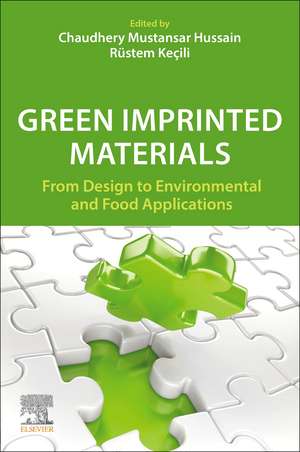Green Imprinted Materials: From Design to Environmental and Food Applications
Editat de Rüstem Keçili, Chaudhery Mustansar Hussainen Limba Engleză Paperback – 21 mar 2024
This book is a valuable resource for researchers and graduate students in molecular imprinting science and technology and those interested in green chemistry and all those who wish to broaden their knowledge in the allied field.
- Explores innovative strategies to materials science, molecular imprinting technology, polymer chemistry and green chemistry, as well as their applications for environmental, biological and food samples
- Presents a plethora of novel and advantageous materials which have gathered the most pronounced attention over recent years
- Provides state-of-the-art technologies and applications in MIP’s and green chemistry
Preț: 904.66 lei
Preț vechi: 1182.83 lei
-24% Nou
Puncte Express: 1357
Preț estimativ în valută:
173.11€ • 188.62$ • 145.87£
173.11€ • 188.62$ • 145.87£
Carte tipărită la comandă
Livrare economică 16-30 aprilie
Livrare express 19-25 martie pentru 107.80 lei
Preluare comenzi: 021 569.72.76
Specificații
ISBN-13: 9780443154317
ISBN-10: 0443154317
Pagini: 484
Dimensiuni: 152 x 229 x 25 mm
Greutate: 0.78 kg
Editura: ELSEVIER SCIENCE
ISBN-10: 0443154317
Pagini: 484
Dimensiuni: 152 x 229 x 25 mm
Greutate: 0.78 kg
Editura: ELSEVIER SCIENCE
Cuprins
SECTION 1: Introduction
1. Green Engineering and Sustainable Chemistry Green Engineering
2. Molecular Imprinting Technology: Fundamentals, Design, Development and Applications of Molecularly Imprinted Materials Molecularly
3. Green chemistry and engineering of molecularly imprinted polymers (MIPs)
4. Green polymerization techniques
SECTION 2: Green MIPs in Sample Pre-treatment
5. Synthesis and characterization of green MIPs and their applications in wastewater treatment
6. Development of green magnetic MIPs for the removal of organophosphorus pesticides (OOPs) Green MIPs (i.e. magnetic MIPS) with super paramagnetism
7. Green MIPs as powerful sorbents for the removal of heavy metals and pharmaceuticals from environmental samples
SECTION 3: Green MIPs in Separation/Identification Stage of Analysis
8. Green magnetic MIPs in food analysis
9. Green magnetic core-shell MIPs for environmental applications
10. Green MIPs for the extraction of mycotoxins in food samples
SECTION 4: Green MIPs in Detection Stage of Analysis/Miniturization devices
11. Electrochemical sensors based on Green MIPs
12. Optical-based (bio)sensing based on green MIPs Optical-based (bio)sensing
13. Quartz crystal microbalance (QCM) sensors based on green MIPs MIPs as artificial antibodies
14. Green MIPs for the detection of food allergens
SECTION 5: CONCLUSIONS
15. Conclusions and future perspectives
1. Green Engineering and Sustainable Chemistry Green Engineering
2. Molecular Imprinting Technology: Fundamentals, Design, Development and Applications of Molecularly Imprinted Materials Molecularly
3. Green chemistry and engineering of molecularly imprinted polymers (MIPs)
4. Green polymerization techniques
SECTION 2: Green MIPs in Sample Pre-treatment
5. Synthesis and characterization of green MIPs and their applications in wastewater treatment
6. Development of green magnetic MIPs for the removal of organophosphorus pesticides (OOPs) Green MIPs (i.e. magnetic MIPS) with super paramagnetism
7. Green MIPs as powerful sorbents for the removal of heavy metals and pharmaceuticals from environmental samples
SECTION 3: Green MIPs in Separation/Identification Stage of Analysis
8. Green magnetic MIPs in food analysis
9. Green magnetic core-shell MIPs for environmental applications
10. Green MIPs for the extraction of mycotoxins in food samples
SECTION 4: Green MIPs in Detection Stage of Analysis/Miniturization devices
11. Electrochemical sensors based on Green MIPs
12. Optical-based (bio)sensing based on green MIPs Optical-based (bio)sensing
13. Quartz crystal microbalance (QCM) sensors based on green MIPs MIPs as artificial antibodies
14. Green MIPs for the detection of food allergens
SECTION 5: CONCLUSIONS
15. Conclusions and future perspectives
